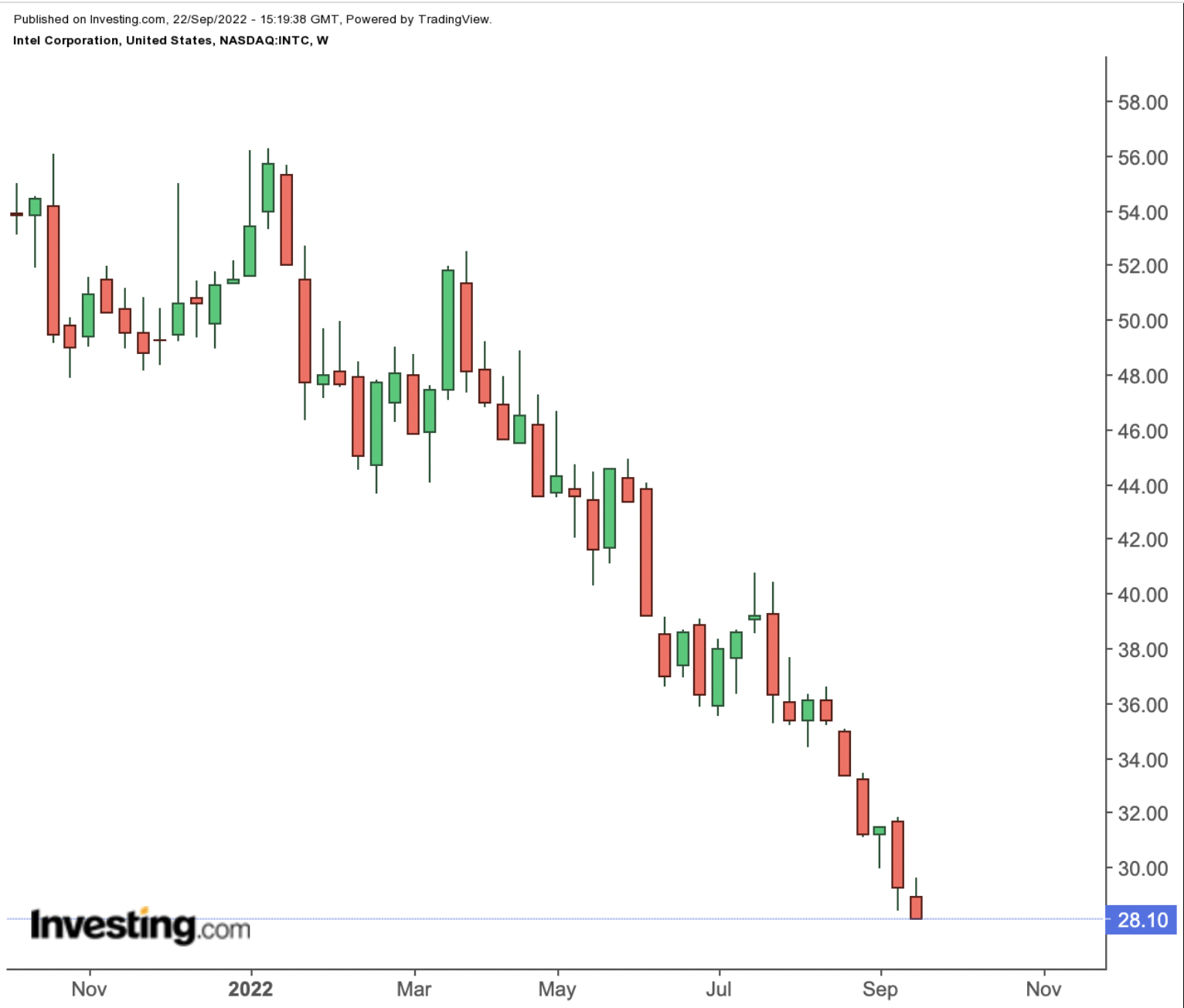Intel Has A Long Road Ahead
2022.09.22 12:36
[ad_1]
- Amid a difficult year, Intel seems to be falling further behind rivals
- A long-term turnaround plan offers hope and the potential for the company to recapture market share
- Short- and long-term questions about that plan raise caution toward INTC stock
It has been a disastrous year for Intel Corporation (NASDAQ:). Year-to-date, INTC has lost 45% of its value, pushing its market capitalization down by more than $90 billion. The in late July was one of the most disappointing a company of Intel’s size has ever produced.
Revenue is declining. Profits are crashing. And Intel appears to be ceding market share to its rivals, most notably Advanced Micro Devices (NASDAQ:).

Source: Investing.com
Yet, amid all that negativity, there still is a long-term case for the stock. After the stunning decline this year, INTC now trades at a six-year low. The company has a long-term turnaround plan in place. The CHIPS Act, passed this summer, provides billions of dollars in subsidies for Intel to build new manufacturing plants in the U.S.
That long-term case has two big questions. The first, obviously, is if it will work. The second is whether investors will have the patience to wait for a multi-year plan to succeed.
A Promising History For INTC
Intel’s goal is to return to its former spot atop the industry — and if that plan works out, the upside here is substantial. The long-term trends that boosted semiconductor stocks in 2020 and 2021 — growth in chip-heavy electric vehicles, expansion of the Internet of Things, the need for ever larger computing power — all remain intact.
Of course, the same is true for the cyclical nature of the chip industry, despite optimistic predictions to the contrary in recent years. Intel has been here before, or at least Intel stock has. Yes, the stock is down 45% year-to-date, but it fell 44% in 2008, 50% in 2002, and 44% in 1981.
Each time, shares roared back. In 1982, INTC gained 72%. In 2003, it more than doubled. In 2009, it rallied by 44%.
Will Intel Succeed?
The question is whether this time will be different. Certainly, Intel’s environment is quite different. In 2003 and 2009, for instance, AMD was a second-tier player that competed largely on price. Now, its chips perform better than those of Intel in many key applications.
And Intel’s execution is quite different, and not for the better. The company still is playing catch-up after delaying its 7-nanometer manufacturing process in 2020. The Sapphire Rapids server chip was due in 2021; it won’t launch in volume until next year.
Rivals aren’t standing still, either. AMD clearly has caught up to Intel in terms of designing end-chips. Samsung Electronics (OTC:) and Taiwan Semiconductor Manufacturing (NYSE:) are investing billions in cutting-edge manufacturing capability. Intel’s long-time edge has been its integrated model; simply put, the company had the best designs and the best manufacturing. Right now, it appears to have neither.
It’s going to take years for Intel to recapture one or the other. And there’s no guarantee of success. Early returns don’t look promising. The second-quarter earnings report was called a “generational miss” by one analyst. Intel’s full-year guidance of $2.30 was stunningly below a consensus estimate of $3.60. Incredibly, Intel’s revenue dropped 22% in the same quarter AMD’s sales increased by 70%.
Intel Stock Right Now
All that said, Intel can’t be written off. While the company has lost share, it’s still a giant: its revenue this year will be more than double that of AMD. There is some hope that delayed products eventually will catch up to rivals. The massive investments being made now should pay off down the line.
And while the stock doesn’t necessarily look cheap right now — it trades at about 12x this year’s earnings, not out of line with its past range — earnings may well be a bottom. PC sales, in particular, have plunged this year after companies and consumers bought heavily amid the remote work boom caused by the novel coronavirus pandemic. A cyclical business — and, again, semiconductors clearly are a cyclical business — should have a higher multiple at the bottom, given that eventually the cycle will reverse in that business’s favor.
Again, that reversal has played out in Intel’s favor in the past. It’s why the stock roared back from big declines on multiple occasions. The two questions now are if the company is strong enough to take advantage of the next upswing — and when investors will be willing to look ahead long enough to price that in.
Disclaimer: As of this writing, Vince Martin has no positions in any securities mentioned.
[ad_2]
Source link







